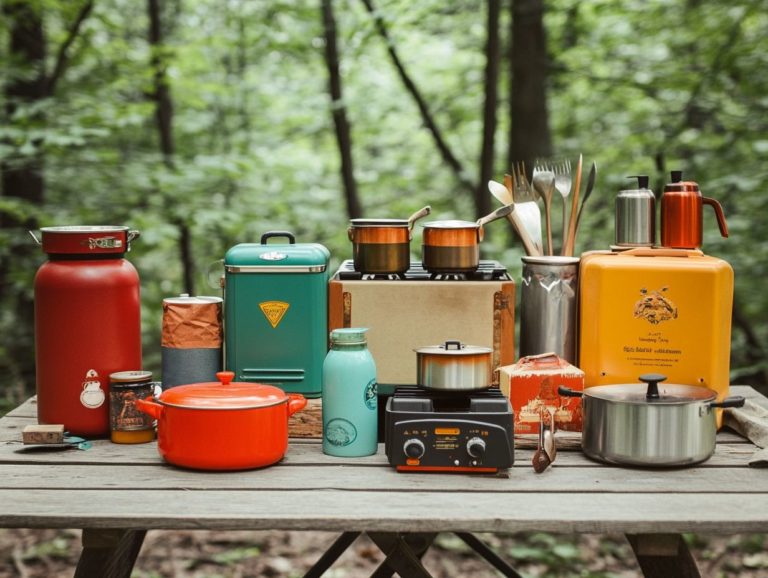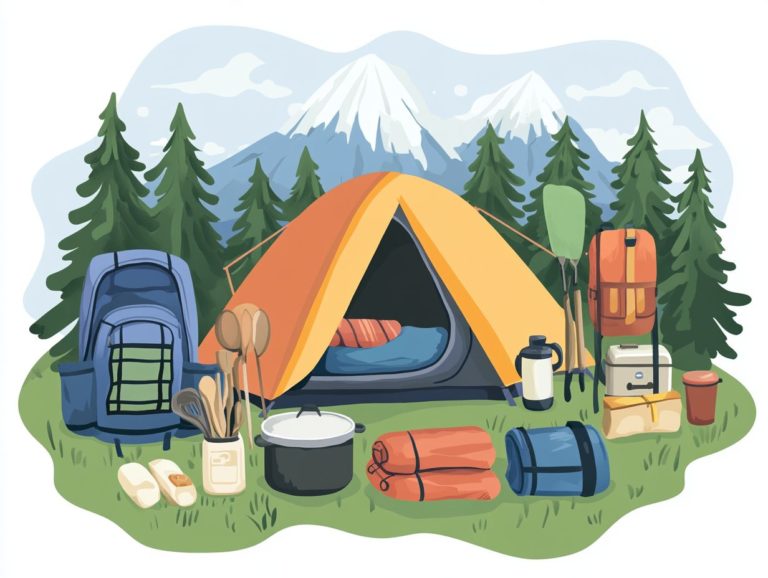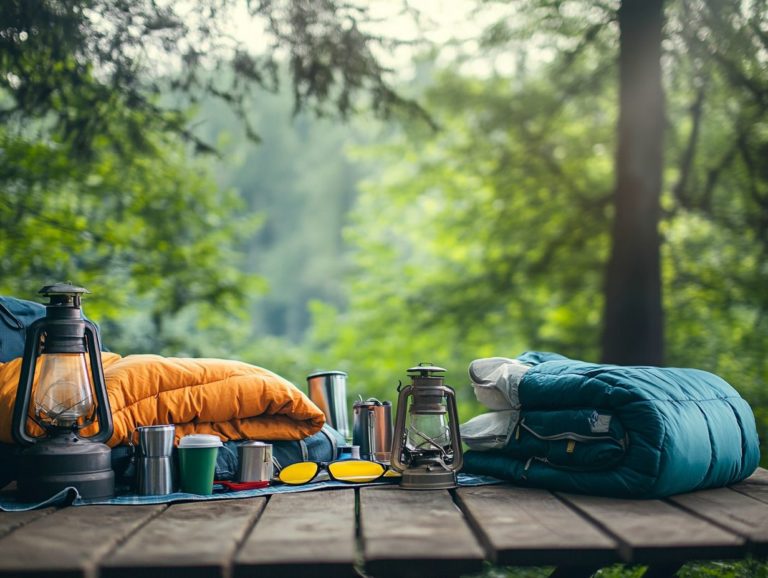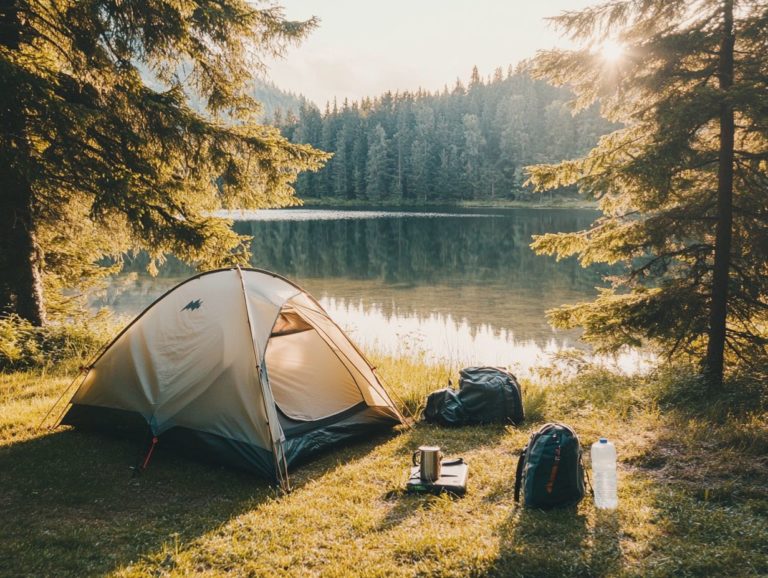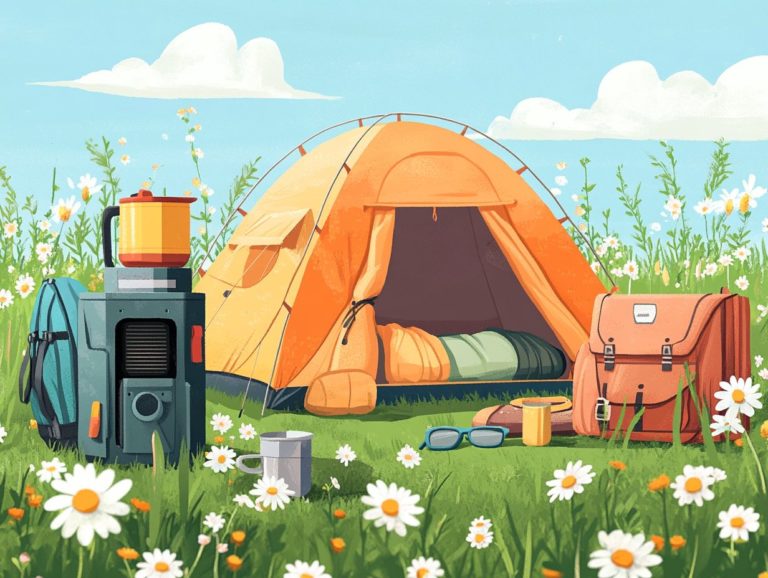How to Stay Warm While Camping in Cold Weather
Camping in cold weather can indeed be a thrilling experience, but it demands careful planning to guarantee your comfort and safety.
From choosing the right gear and clothing to constructing a warm shelter, staying cozy at night, and savoring hearty meals, every detail is crucial.
This guide presents essential tips and techniques for navigating the chill, including vital safety precautions to shield against hypothermia.
Get ready to dive into the wild like never before! It s time to gear up for your cold-weather adventure!
Contents
- Key Takeaways:
- Preparing for Cold Weather Camping
- Building a Warm and Insulated Shelter
- Staying Warm at Night
- Keeping Warm During the Day
- Food and Hydration for Cold Weather Camping
- Safety Precautions for Cold Weather Camping
- Frequently Asked Questions
- What are some tips for staying warm while camping in cold weather?
- What type of clothing should I bring to stay warm while camping in cold weather?
- Can I stay warm while camping in a tent?
- What are some signs of hypothermia and how can I prevent it?
- Can I camp in cold weather without a campfire?
- What should I do if I get too cold while camping in cold weather?
Key Takeaways:
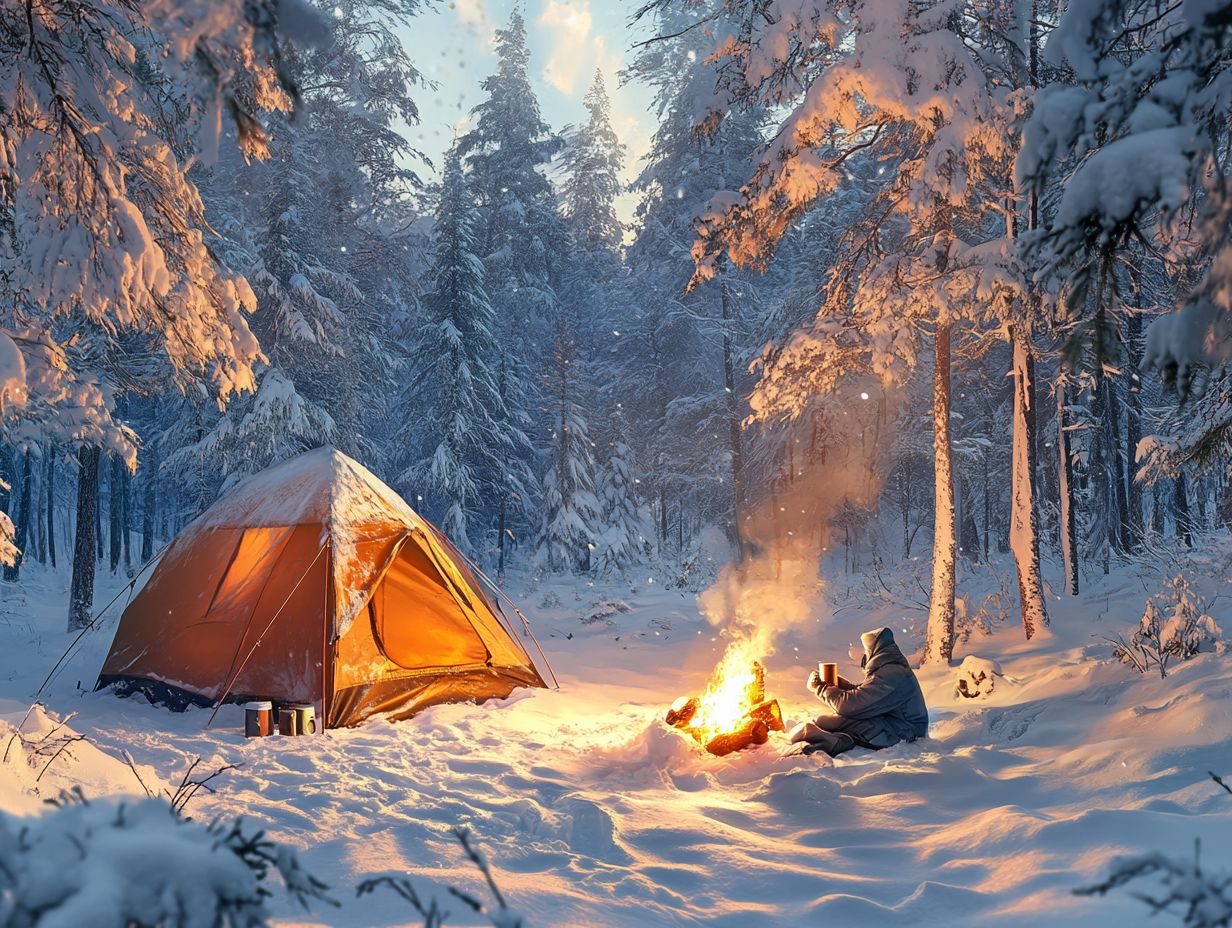
- Investing in proper gear is essential for staying warm while camping in cold weather.
- Choose a shelter that helps keep you warm and know how to properly insulate it to stay warm at night.
- Stay active and fuel your body with warm, satisfying food and drinks to maintain warmth during the day.
Preparing for Cold Weather Camping
Preparing for cold weather camping requires careful planning that harmonizes comfort with safety, ensuring you’re fully equipped to tackle the often unforgiving conditions of winter landscapes.
Each detail matters, from selecting the ideal backcountry gear to understanding the critical role of insulation and warmth.
The right camping tips can transform your experience, guiding you in picking a tent that can withstand frigid temperatures and layering your clothing for optimal comfort.
By following these strategies, you can relish your outdoor adventures while maintaining both safety and comfort.
Essential Gear and Clothing
Essential gear and clothing are pivotal for ensuring your winter camping experience is not only successful but also enjoyable.
It’s crucial to pick a sleeping bag and tent that can handle low temperatures. These essentials provide the insulation and protection you need against the elements, allowing you to focus on the beauty of nature without shivering in discomfort.
Layering your clothing with moisture-wicking base layers and opting for high-quality materials like Merino wool can significantly elevate your comfort levels. This way, you can fully immerse yourself in the great outdoors without the nagging chill and dampness.
To take your warmth to the next level, think about adding insulated liners to your sleeping bag and choosing tents rated for four seasons, built to withstand even the harshest winter conditions.
Don’t overlook accessories; insulated gloves and hats are critical since a significant amount of heat escapes through your extremities.
Choosing between synthetic and down-fill sleeping bags can greatly affect how warm you stay.
Ultimately, equipping yourself with the right gear enables you to embrace the frigid outdoors, transforming potential challenges into unforgettable adventures while ensuring your safety and comfort throughout your journey.
Building a Warm and Insulated Shelter
Constructing a warm and insulated shelter is essential for your winter camping experience, as it profoundly influences your comfort and safety in harsh weather conditions.
Implementing proper tent safety measures like choosing a location free from the threat of falling snow and ensuring adequate ventilation is fundamental to preventing heat loss and maintaining a stable internal temperature.
By employing techniques such as digging a snow pit for insulation or incorporating a wood stove for added warmth, you can cultivate a cozy environment that significantly mitigates the effects of cold exposure, ultimately enhancing your overall camping adventure.
Types of Shelters and How to Insulate Them
When considering winter camping, you have a variety of shelter options to explore. Each is designed to provide the insulation and warmth necessary for cold weather conditions.
From traditional tents engineered for winter performance to more innovative backcountry gear like igloos or snow caves, your choices are abundant. It’s essential to understand how to insulate these shelters effectively.
Utilizing materials such as natural snow for insulation or incorporating reflective surfaces can greatly enhance warmth and comfort when temperatures plummet. Each type of shelter presents its own benefits and challenges, so choose based on your specific needs and experiences.
For instance, winter tents often feature reinforced fabrics and interior pockets for gear storage. They offer convenience but require careful setup to ensure stability against wind.
On the other hand, igloos constructed from snow blocks excel in thermal regulation, but they demand considerable effort and skill to build. Snow caves provide outstanding insulation with their thick walls, yet you ll want local knowledge to discover a safe location.
Don t underestimate the importance of ventilation. A well-ventilated shelter prevents moisture buildup and fosters a more comfortable environment. Striking the right balance among these factors is key to a successful winter camping adventure.
Staying Warm at Night
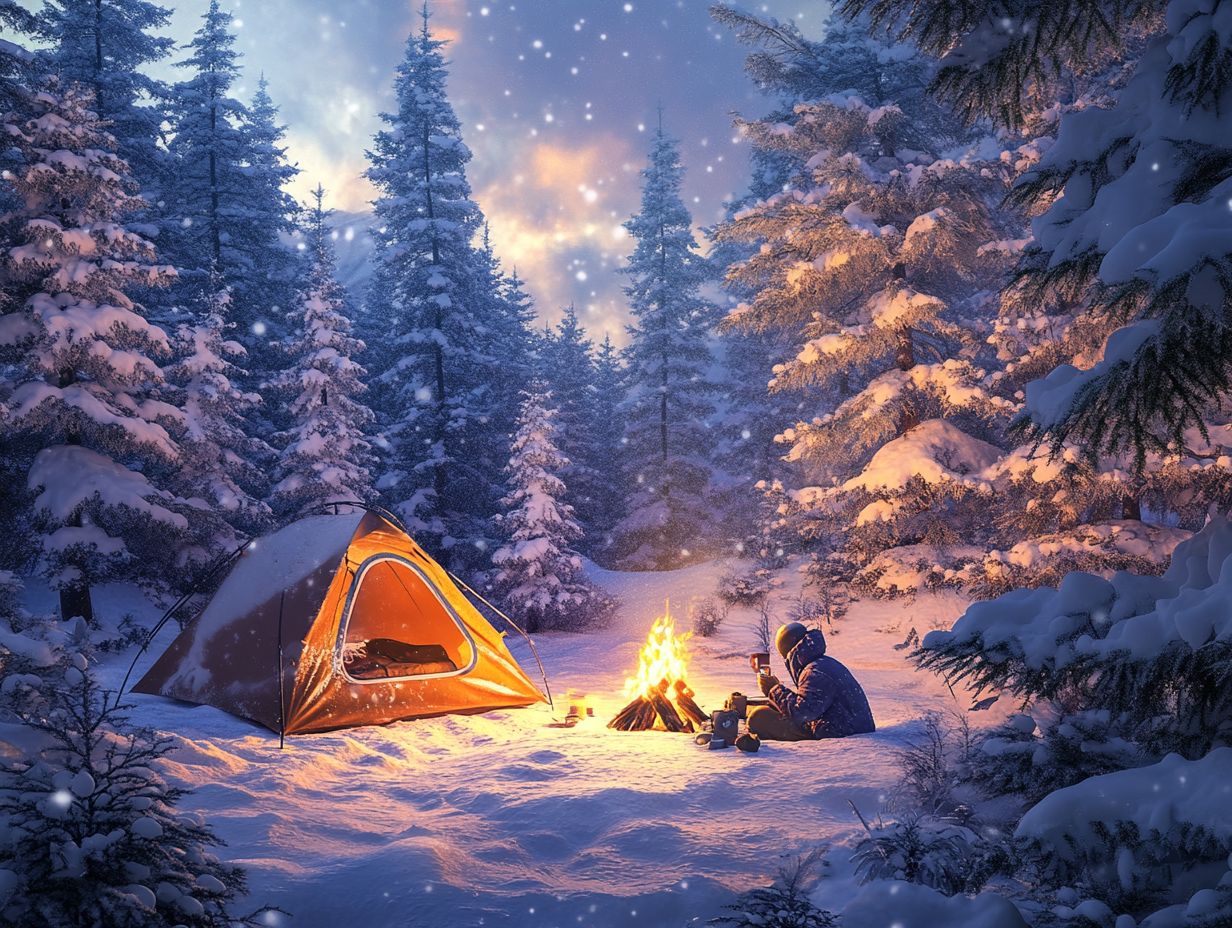
Staying warm at night is essential for an unforgettable winter camping experience! Those frigid temperatures can turn your adventure into an uncomfortable situation or worse, a dangerous situation if not managed properly.
Use a high-quality sleeping bag rated for the temperatures you expect. This will effectively trap body heat and offer reliable insulation.
Layer your clothing wisely. Think of it as your personal warmth armor. Techniques like snuggling up with a hot drink in a thermos can significantly elevate your warmth and comfort throughout the night.
Pay attention to how you manage exhalations and moisture inside your shelter. If left unchecked, moisture can lead to condensation, adding to your chill.
Tips for Sleeping Comfortably in Cold Temperatures
To enjoy a cozy night s sleep in cold temperatures, adopt strategies that focus on warmth. Insulation is key.
Start by considering the thermal ratings of sleeping bags. These ratings indicate how well a bag keeps you warm based on expected nighttime conditions. Choose a bag rated for temperatures lower than what you anticipate for the night.
Layering your clothing is equally important. Opt for moisture-wicking base layers combined with insulating mid-layers to trap warmth close to your body.
Value insulated sleeping pads. They act as a barrier against the cold ground, reducing heat loss while you sleep. Remember, ventilation matters; allow adequate airflow within your tent to prevent condensation buildup, which could lead to dampness and discomfort.
Small comforts, like placing a hot water bottle near your core, can make a world of difference in keeping you warm and comfortable throughout the night. This way, you ll wake up refreshed and ready for your next adventure!
Keeping Warm During the Day
Maintaining warmth throughout the day during winter camping is vital for your comfort and energy levels. This allows you to fully embrace outdoor activities.
Engaging in physical pursuits like hiking or skiing not only enhances your warmth but also enriches your appreciation of the stunning winter landscape.
It’s essential to layer your clothing wisely to prevent overheating and sweating, which can expose you to the cold later on. To keep your body generating heat effectively, indulge in high-calorie foods and stay hydrated with warm beverages.
This approach ensures you can truly savor every moment of your camping experience. So, gear up and plan your winter adventure today!
Activities and Techniques to Stay Warm Outdoors
Engaging in specific activities and techniques is essential for staying warm during cold weather camping. Physical exertion naturally generates body heat. Consider hiking or snowshoeing. These not only provide an excellent workout but also offer the chance to explore breathtaking winter landscapes.
Incorporate regular breaks for hot drinks or high-calorie foods. This helps maintain warmth and energy levels throughout the day. Managing your clothing layers effectively is key to enhancing your comfort, allowing you to adjust based on how active you feel.
Snowboarding is another great way to embrace the cold while staying active. The thrill of the ride can spark an adrenaline rush that helps keep you warm!
When you’re outdoors, remember to dress in moisture-wicking base layers fabric that keeps you dry by pulling moisture away from your skin insulating mid-layers, and waterproof outer layers. This combination traps heat like a cozy hug and makes a significant difference in your comfort.
Nourishing snacks like nuts or energy bars are your best friends. They provide essential calories to sustain energy for extended physical activity. Warm drinks such as herbal tea or hot cocoa not only enhance your experience but also provide comfort and hydration while fending off the chill!
By employing these strategies, you can ensure a more enjoyable and comfortable time outdoors, even during the coldest months.
Food and Hydration for Cold Weather Camping
Food and hydration are vital for winter camping. Your body demands extra energy to stay warm and functional in frigid conditions. Indulge in high-calorie foods that power your outdoor adventures.
Warm drinks do more than just quench your thirst; they elevate your internal body temperature, helping you fend off the cold. Picture a thermos brimming with steaming hot beverages or a hearty meal like Mountain House Beef Stroganoff.
With the right nutrition, you can elevate your camping experience. Ensure you remain energized and cozy throughout your adventure!
Best Foods and Drinks to Keep You Warm and Satisfied
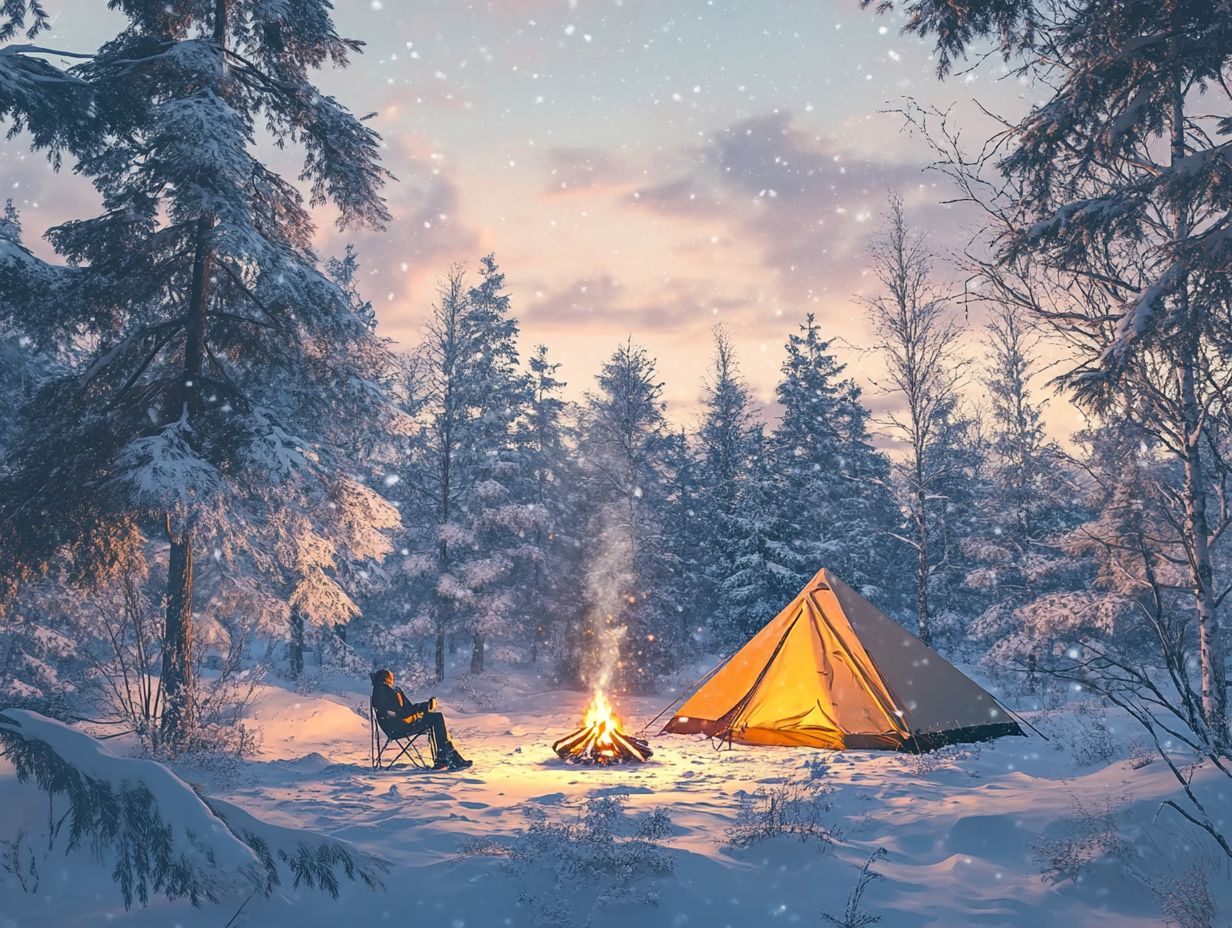
The finest foods and drinks to keep you warm and satisfied during winter camping focus on high-calorie nutritional value and the comforting embrace of warmth. Think hearty meals like beef stew or steaming hot soups that not only provide energy but also offer comfort against the cold.
Hot beverages, such as rich tea and robust coffee, can be enjoyed while taking in the stunning views of the Coast Mountains.
Choose meals that are easily prepared in a single pot, like chili or instant oatmeal. This simplifies your experience and minimizes cleanup. Packing these meals in vacuum-sealed bags or reusable containers ensures they stay fresh and are easy to transport.
Don t overlook the power of snacks like trail mix or energy bars. They deliver quick energy boosts without requiring extensive preparation. Don’t forget to pack your Nalgene bottles with warm drinks! Insulated thermoses can keep your drinks hot longer, turning each sip into a delightful and revitalizing experience.
These considerate choices not only fuel your body but also create a cozy atmosphere amidst the chilly landscape. To enhance your comfort, learn how to stay warm while hiking. This ensures that winter camping remains a comfortable and enjoyable adventure!
Safety Precautions for Cold Weather Camping
Safety precautions for cold weather camping are absolutely essential for a secure and enjoyable outdoor adventure. Exposure to extreme cold poses serious risks, including hypothermia and frostbite, especially in areas with significant snowfall like Whistler in British Columbia. Awareness of the signs of cold-related injuries is crucial.
Recognizing these signs allows you to act swiftly to protect yourself and your companions. Implement strategies like proper layering, maintaining warmth, and staying informed about weather conditions. These will significantly reduce risks during your camping trip.
Having safety gear easily accessible ensures you re prepared to respond effectively in case of an emergency!
How to Avoid Hypothermia and Other Cold-Related Injuries
Avoiding hypothermia and other cold-related injuries during your winter camping trips demands vigilance and proactive measures. These conditions can escalate rapidly in cold weather.
By implementing effective layering techniques, you can retain body heat and significantly reduce the risk of cold exposure. Check on yourself and your friends for signs of hypothermia such as shivering, confusion, and loss of coordination so you can intervene early if needed.
Staying informed about weather conditions and having a solid contingency plan will add an extra layer of safety to your adventure.
To maximize warmth retention, choose your fabric layers wisely. Prioritize materials that keep you dry, like Merino wool (a type of wool that keeps you warm even when wet), closest to your skin, followed by insulating layers made of fleece or down. Finish off with a waterproof outer shell to protect against wind and snow.
Don t underestimate the power of thermal accessories! Hats and gloves can trap heat effectively.
Positioning yourself within a shared tent can boost warmth through collective body heat. Keeping your sleeping areas dry will enhance both comfort and safety during rest periods.
Check for frostbite regularly, especially after spending time in areas prone to avalanches. Ensure you take regular breaks to warm up. This will help maintain your energy and overall enjoyment throughout your winter camping experience.
Frequently Asked Questions
What are some tips for staying warm while camping in cold weather?
- Layer up with appropriate clothing – Wear multiple layers of clothing to trap heat and insulate your body. Include a base layer, mid-layer, and outer layer.
- Use a sleeping bag with a lower temperature rating – Invest in a sleeping bag suitable for the expected temperature range of your camping destination.
- Stay hydrated – Drinking plenty of water helps regulate your body temperature and keep you warm.
- Use hand and foot warmers – Pack hand and foot warmers to keep extremities warm and prevent frostbite.
- Insulate your tent – Place a layer of tarp or an insulated mat under your tent to prevent heat loss from the ground.
- Build a campfire – A campfire not only provides warmth but also creates a cozy atmosphere for your camping experience.
What type of clothing should I bring to stay warm while camping in cold weather?
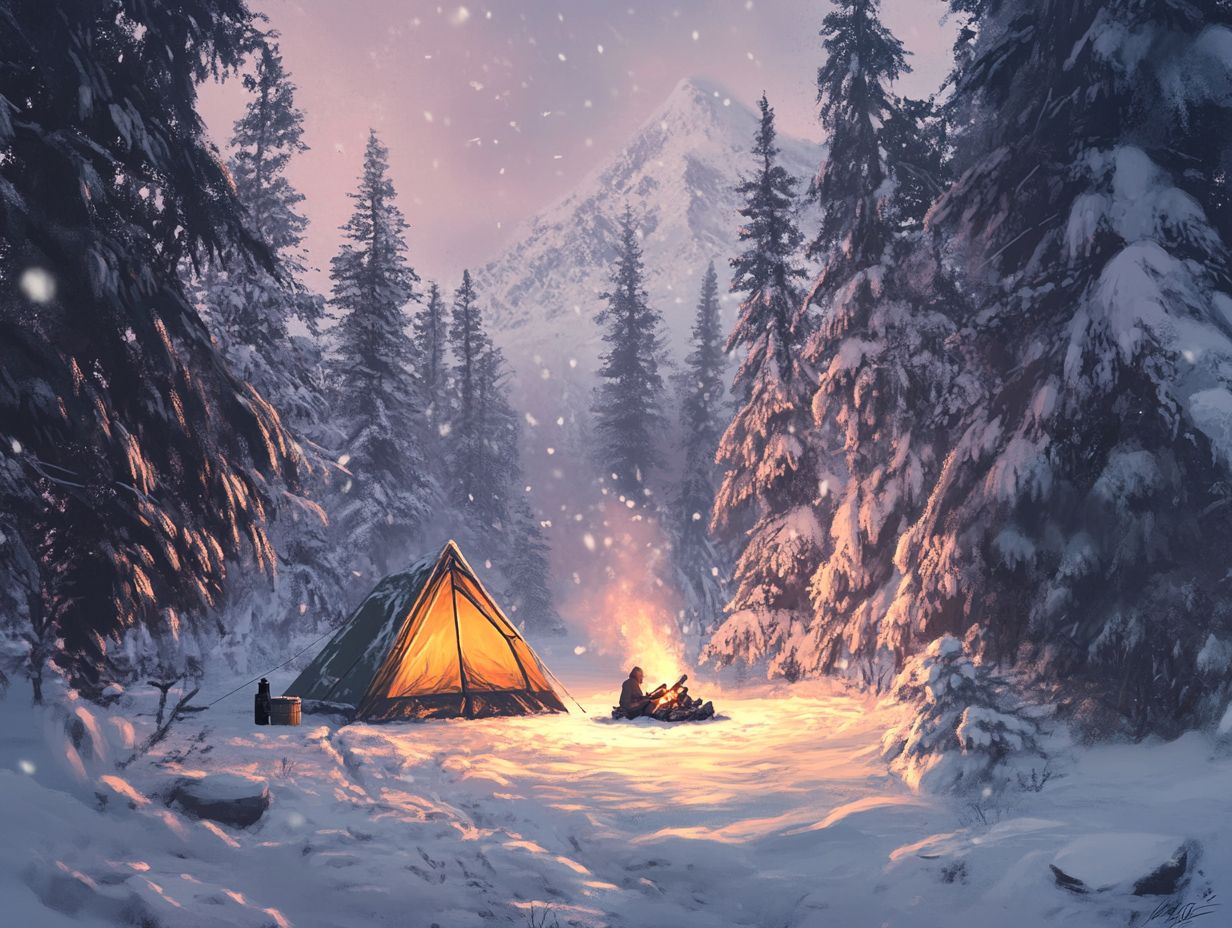
It’s important to pack clothes made of materials suitable for cold weather. This includes Merino wool, fleece, and synthetic materials designed for insulation. Avoid cotton as it retains moisture and can make you feel colder.
Can I stay warm while camping in a tent?
Yes! You can stay warm while camping in a tent by properly insulating your tent and using appropriate clothing and gear. Also, ensure proper ventilation to prevent condensation buildup that can make you feel colder.
What are some signs of hypothermia and how can I prevent it?
Signs of hypothermia include shivering, confusion, slurred speech, and loss of coordination. To prevent hypothermia, dress in warm layers, stay dry, and seek shelter in a warm place if necessary. Watch for these signs in others and seek medical attention if needed.
Can I camp in cold weather without a campfire?
Yes! You can still stay warm while camping in cold weather without a campfire. Insulate your tent, dress in warm layers, and use hand and foot warmers if necessary. Consider bringing a portable heater if allowed at your campsite.
What should I do if I get too cold while camping in cold weather?
If you start to feel too cold, seek shelter in a warm place, change into dry clothing, and warm up gradually. Avoid warming up too quickly, as it can lead to discomfort or even hypothermia. Stay hydrated and eat warm, high-calorie foods to help maintain your body’s energy and warmth.

